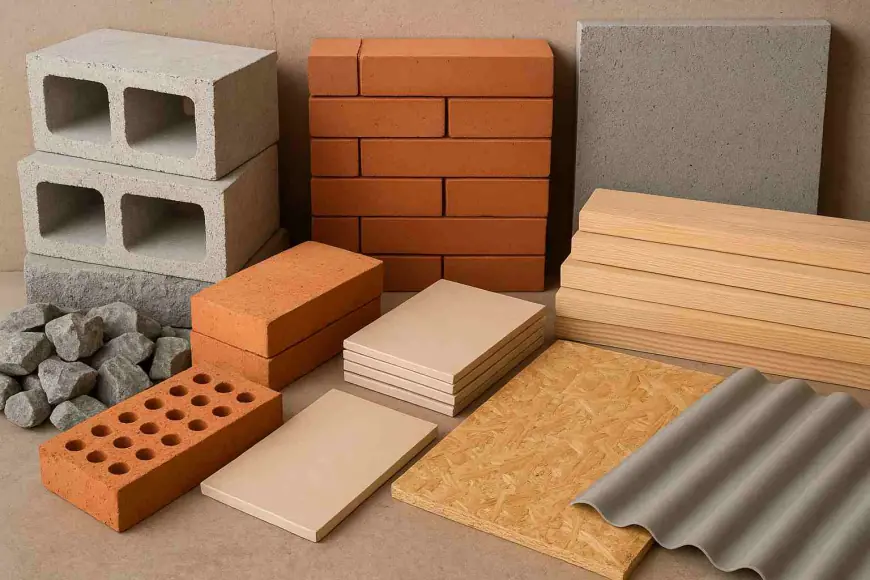How Sustainable Building Materials Can Lower Carbon Footprints
Discover how sustainable building materials can lower carbon footprints and improve energy efficiency. Learn why partnering with eco-focused building materials suppliers and a trusted steel stockist in UAE is key to greener, cost-effective construction projects.

The construction industry is one of the largest contributors to global carbon emissions. From raw material extraction to on-site construction and long-term maintenance, each stage of the building lifecycle impacts the environment. Today, businesses, developers, and governments are increasingly prioritizing sustainability. A key aspect of this shift lies in the selection of building material suppliers who focus on eco-friendly solutions. By choosing sustainable products and practices, the industry can significantly reduce its carbon footprint while also meeting growing demand for green infrastructure.
The Role of Building Materials in Carbon Emissions
Every building material carries a “carbon cost.” Traditional materials such as concrete, steel, and glass require high energy input for production, leading to significant emissions. Transporting and installing these materials further increases their environmental impact.
However, by working with reliable building materials suppliers, contractors, and developers, they can identify sustainable alternatives that balance durability, performance, and environmental responsibility. Whether it’s recycled steel, bamboo, engineered wood, or low-carbon concrete, sustainable materials play a crucial role in minimizing embodied carbon in construction.
What Makes a Building Material Sustainable?
Not all eco-friendly claims are equal. For materials to be considered sustainable, they must meet several criteria:
-
Low Embodied Energy—The total energy required for extraction, processing, and transportation should be minimal.
-
Recyclability & Reusability—Materials like steel and aluminum can be recycled multiple times without losing structural strength.
-
Durability & Longevity—Longer life cycles mean fewer replacements and reduced environmental impact.
-
Locally Sourced—Materials supplied by regional building materials suppliers cut down on transportation-related emissions.
-
Non-Toxic & Safe – Products should avoid harmful chemicals that affect human health and the environment.
Examples of Sustainable Building Materials
1. Recycled Steel
Steel is one of the most recyclable construction materials. Using recycled steel significantly reduces the carbon footprint associated with mining and manufacturing virgin steel.
2. Cross-Laminated Timber (CLT)
A strong, lightweight alternative to concrete and steel, CLT stores carbon absorbed during a tree’s lifetime, making it carbon-negative in many cases.
3. Bamboo
Known for its rapid growth and tensile strength, bamboo is increasingly recognized as a sustainable substitute for hardwood and even steel in certain applications.
4. Low-Carbon Concrete
Innovations in cement technology are leading to greener alternatives, including fly ash concrete and geopolymer concrete.
5. Recycled Plastic and Composites
Turning plastic waste into building materials reduces landfill burden while offering durability for applications such as flooring, roofing, and insulation.
How Building Materials Suppliers Drive Change
Sustainability in construction isn’t just about material choice—it’s also about who supplies them. Progressive building materials suppliers are adopting green practices across their operations, such as:
-
Offering eco-certified and responsibly sourced products.
-
Providing transparent information on lifecycle impacts.
-
Reducing packaging waste and promoting bulk supply.
-
Encouraging the use of recycled and reclaimed materials.
By partnering with such suppliers, contractors can align with green building certifications like LEED, BREEAM, or Estidama, while enhancing their reputation as environmentally responsible businesses.
Benefits of Using Sustainable Building Materials
Choosing eco-friendly materials delivers benefits beyond lowering carbon footprints.
-
Energy Efficiency—Many sustainable materials improve insulation, reducing operational energy needs.
-
Cost Savings—Though some options carry higher upfront costs, long-term savings in maintenance and energy consumption outweigh the investment.
-
Healthier Living Spaces—Non-toxic materials improve indoor air quality for occupants.
-
Regulatory Compliance—Governments are tightening building codes around sustainability, making early adoption essential.
-
Enhanced Market Value—Green buildings are increasingly in demand among tenants and investors.
The Future of Sustainable Construction
As global cities aim for net-zero targets, demand for sustainable materials will only grow. Innovations in material science, coupled with pressure from regulators and consumers, are pushing building materials suppliers to expand their sustainable product ranges. From carbon-capturing concrete to modular construction techniques, the next decade will transform how buildings are designed and built.
Conclusion: Choosing the Right Supplier Matters
Lowering carbon footprints in construction starts with material choices—and those choices depend heavily on suppliers. Partnering with trusted building materials suppliers ensures that every stage of construction contributes positively to environmental goals.
If you are looking to embrace sustainable construction practices and secure reliable, high-quality materials, now is the time to act. Explore leading options and connect with a trusted steel stockist in UAE to begin building greener, more resilient projects that meet both today’s needs and tomorrow’s challenges.
What's Your Reaction?
 Like
0
Like
0
 Dislike
0
Dislike
0
 Love
0
Love
0
 Funny
0
Funny
0
 Angry
0
Angry
0
 Sad
0
Sad
0
 Wow
0
Wow
0







![Introduction ✈98~[(2121)]?~[{0875}] to the Stock market courses](https://joripress.com/uploads/images/202509/image_430x256_68bf0343969fb.webp)








































